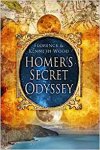Where Troy Once Stood: The Mystery of Homer's Iliad & Odyssey Revealed
I'm wondering whether this new edition is somehow different and whether it would be better to get the older version? I know this is a really small detail but it crossed my mind and I had to ask:)Laura said:I'm not sure why it is so expensive. One thing I sort of picked up on was that Wilkens sold the rights to the original publisher who did a run or two and then it went out of print. So, Wilkens, having sold the rights, couldn't do anything about it except to come out with a different edition and self-publish at some considerable expense.




